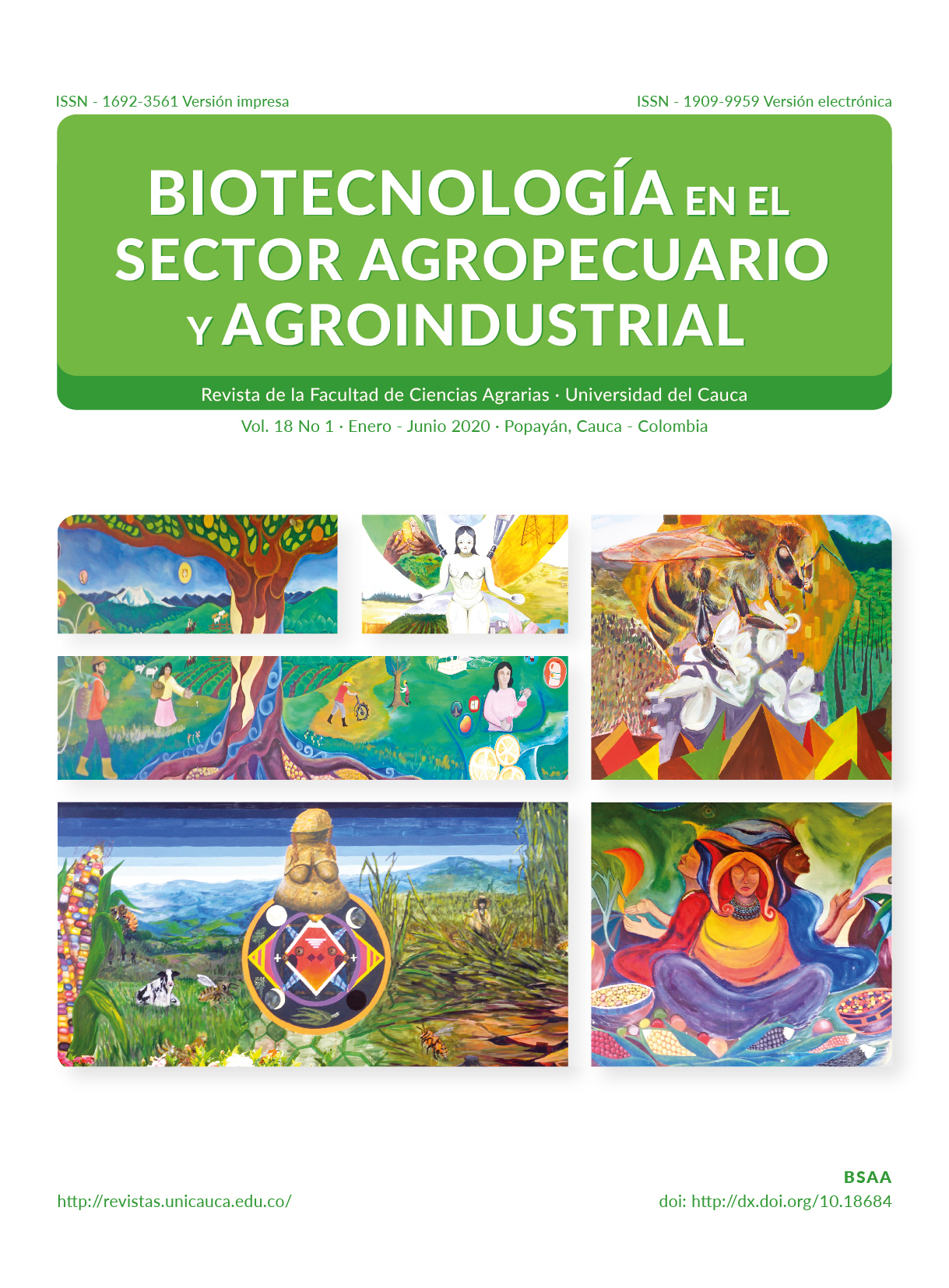Evaluación morfoagronómica de 19 materiales de Chenopodium quinoa en el Departamento de Boyacá
Resumen
La quinua (Chenopodium quinoa Wild.) es un cultivo de grano que se cultiva en la región de los Andes desde los valles centrales de Colombia hasta la zona sur de Chile. En Colombia, es un cultivo de pequeña escala, donde el conocimiento de su variabilidad es reducido. Dentro de este contexto, esta investigación tuvo como objetivo principal realizar una caracterización morfológica a 19 materiales de quinua en el departamento de Boyacá utilizando 27 descriptores morfológicos. La estimación de la variación morfológica se hizo mediante el análisis de correlación, componentes principales y conglomerados. Los resultados muestran que los coeficientes de variación más altos se encontraron en los caracteres cuantitativos. Los análisis de componentes principales explicaron más del 70% de la variación observada siendo las características presencia y color de axilas, presencia y color de estrías, altura de la planta, número de panojas, rendimiento de semillas por planta y peso de 1000 granos. Los conglomerados mostraron una distribución laxa de todos los individuos evaluados con rendimientos y peso de grano promedios, y la relación entre la quinua y la especie relacionada kiwicha. La caracterización morfológica de estos materiales pone de manifiesto la existencia de variabilidad que puede ser utilizada en programas de conservación y mejoramiento genético de la especie en el departamento de Boyacá.
Descargas
Disciplinas:
AgropecuariaLenguajes:
EspañolReferencias bibliográficas
2 SCHMÖCKEL, S., LIGHTFOOT,D., RAZALI, R., TESTER, M. and JARVIS, D. Identification of putative transmembrane proteins involved in salinity tolerance in Chenopodium quinoa by integrating physiological data, RNAseq and SNP analyses. Frontiers in Plant Science, 21, 2017, p. 1023, DOI: https://doi.org/10.3389/fpls.2017.01023
3 REGUERA, M., CONESA, C.M., GIL-GOMEZ, A., HAROS, C.M., PÉREZ-CASAS, M.A., BRIONES-LABARCA, V., BOLAÑOS, L., BONILLA, I., ÁLVAREZ, R. PINTO, K., MUJICA, A. and BASCUÑAN, L. The impact of different agroecological conditions on the nutritional composition of quinoa seeds. Peer Journal, 6, 2018, p. 1-20, DOI: https://doi.org/10.7717/peerj.4442.
4 ALVAREZ, R., NGUYEN, A., PEREDO, S., JOFFRE, R. and WINKEL, T. Rooting plasticity in wild and cultivated Andean Chenopodium species under soil water deficit. Plant Soil, 425, 2018, p. 479-492, DOI: https://doi.org/10.1007/s11104-018-3588-7.
5 HUSSIN, S., KHALIFA, W., GEISSLER, N. and KOYRO, H.W. Influence of the root endophyte Piriformospora indica on the plant water relations, gas exchange and growth of Chenopodium quinoa at limited water availability, Journal of Agronomy and Crop Science, 203, 2017, p. 373–384, DOI: https://doi.org/10.1111/jac.12199.
6 PEREIRA, E., ENCINA, C., BAROS, L., GONZALES, U., CADAVEZ, U. and FERREIRA, I. Chemical and nutritional characterization of Chenopodium quinoa Willd (quinoa) grains: A good alternative to nutritious food. Food Chemistry, 280, 2019, p. 110-114, DOI: https://doi.org/10.1016/j.foodchem.2018.12.068.
7 VILCACUNDO, R. and HERNÁNDEZ, B. Nutritional and biological value of quinoa (Chenopodium quinoa Willd.). Current Opinion in Food Science, 14, 2017, p. 1-6, DOI: https://doi.org/10.1016/j.cofs.2016.11.007
8 EISA, S., M.A., EID, E.H., ABD, EL-SAMAD., S.A, HUSSIN., A.A, ABDEL-ATI., N.E, EL-BORDENY., S.H, ALI., H.M.A, AL-SAYED, M.E., LOTFY, A.M., MASOUD, A.M., EL-NAGGAR, M. and EBRAHIM, M. Chenopodium quinoa Willd. A new cash crop halophyte for saline regions of Egypt, Australian Journal of Crop Sciencie, 11, 2017, p. 343-351, DOI: https://doi.org/10.21475/ajcs.17.11.03.pne316.
9 BEDOYA, N., PUMI, G., MUJICA, A., TALAMINI, E. and DOMINGOS, A. Quinoa expansion in Peru and its implications for land use. Sustainability, 10, 2018, p. 532-544, DOI: https://doi.org/10.3390/su10020532.
10 ANDREWS, D. Race, Status, and Biodiversity: The social climbing of quinoa. Culture, Agriculture, Food and Environment, 39, 2017, p. 15-24. DOI: https://doi.org/10.1111/cuag.12084.
11 GARCÍA, M., GARCÍA, J. y CARVAJAL, R. Evaluación del efecto de la fertilización química y orgánica en la composición bromatológica de semillas de quinua (Chenopodium quinoa Willd.) en Boyacá-Colombia. Revista de Investigación Agraria y Ambiental, 9, 2018, p. 99-107.
12 DELATORRE, J., SÁNCHEZ, M., DELFINO, I. y OLIVA, M. La quinua (Chenopodium quinoa Willd), un tesoro andino para el mundo. Idesia, 31, 2013, p.111-114.
13 TORRES, J., VARGAS, H., CORREDOR, G. and REYES, I.M. Morpho–agronornic characterization of nineteen cultivars of quinoa (Chenopodium quinoa Willd.) under Bogota’s savanna conditions, Agronomía Colombiana, 17, 2000, p. 61-68.
14 DELGADO, A., PALACIOS, J. y BETANCOURT, C. Evaluación de 16 genotipos de quinua dulce (Chenopodium quinoa Willd.) en el municipio de Iles, Nariño (Colombia), Agronomía Colombiana, 27, 2009, p.159-167.
15 INFANTE, H., ALBESIANO, S., ARRIETA, L. and GÓMEZ, N. Morphological characterization of varieties of Chenopodium quinoa cultivated in the department of Boyacá, Colombia, Revista U.D.C.A. Actualidad & Divulgación Científica, 21, 2018, p. 1-12, DOI: https://doi.org/10.31910/rudca.v21.n2.2018.977.
16 KHALIFA, W. and THABET, M. Variation in downy mildew (Perenospora variabilis Gäum) resistance of some quinoa (Chenopodium quinoa Willd) cultivars under Egyptian conditions, Middle East Journal of Agriculture, 70, 2018, p. 671-682.
17 MORILLO, A., MANJARRES, E. and MORILLO, Y. Molecular characterization of Chenopodium quinoa Willd. Using inter-simple sequence repeat (ISSR) markers. African Journal of Biotechnology, 16, 2017, p. 483-489, DOI: 10.5897/AJB2017.15925.
18 ROJAS, W. Multivariate analysis of genetic diversity of Bolivian quinoa germplasm. Food Reviews International, 19, 2003, p. 9-23. DOI: https://doi.org/10.1081/FRI-120018864.
19 AL-NAGGAR, A., EL SALAM, R., BADRAN, A. and EL-MOGHAZI, M. Heritability and interrelationships for agronomic, physiological and yield traits of quinoa (Chenopodium quinoa Willd.) under elevated water stress, Archives of current research international, 10, 2017, p. 1-15.
20 SPEHAR, C.R. and SANTOS, R.L.D. Agronomic performance of Quinoa selected in the Brazilian Savannah. Pesquisa Agropecuária Brasileira, 40, 2005, p. 609–612, DOI: http://dx.doi.org/10.1590/S0100-204X2005000600012.
21 BHARGAVA, A., SHUKLA, S., RAJAN, S. and OHRI, D. Genetic diversity for morphological and quality traits in quinoa (Chenopodium quinoa Willd.) germplasm, Genetic Resources and Crop Evolution, 54, 2007, p. 167–173, DOI: https://doi.org/10.1007/s10722-005-3011-0.
22 FUENTES, F. and BHARGAVA, A. Morphological analysis of Quinoa germplasm grown under lowland desert conditions, Journal of Agronomy and Crop Science, 197, 2011, p. 124–134, DOI: https://doi.org/10.1111/j.1439-037X.2010.00445.x
23 ALANOCA, C. y MACHACA, E. Caracterización agromorfológica de 10 accesiones y variedades de quinua (Chenopodium quinoa Willd.) en condiciones del Valle Alto de Cochabamba. Revista científica de investigación INFO-INIAF, 1, 2015, p. 21-29.
24 GRAF, B.I., ROJO, L.E., DELATORRE, J., POULEV, A., CALFIO, C. and RASKIN, I. Phytoecdysteroids and flavonoid glycosides among Chilean and commercial sources of Chenopodium quinoa: variation and correlation to physico–chemical characteristics. Science of Food and Agriculture, 96, 2016, p. 633-643, DOI: https://doi.org//10.1002/jsfa.7134.
25 GARCÍA, A., TORRES, O. and ARIZA, H. Physical-chemical characterization of quinoa (Chenopodium quinoa Willd.), amaranth (Amaranthus caudatus L.), and Chía (Salvia hispanica L.) flours and seeds. Acta Agronómica, 67, 2018, p. 215-222, DOI: https://doi.org/10.15446/acag.v67n2.63666.
26 CURTI, R.N., DE LA VEGA, A.J., ANDRADE, A.J., BRAMARDI, S.J. and BERTERO, H.D. Multi-environmental evaluation for grain yield and its physiological determinants of quinoa genotypes across Northwest Argentina. Field Crops Research, 166, 2014, p. 46–57, DOI:https://doi.org/10.1016/j.fcr.2014.06.011
27 FAROOQ, M., AZIZ, S., AZIZ, A., JAVAID, M., MUHAMMAD, H., WASAYA, A., AHMAD, T. and WAHID, A. Morphological features of different accessions of Chenopodium quinoa. Pure and Applied Biology, 7, 2018, p. 374-383, DOI:http://dx.doi.org/10.19045/bspab.2018.70046
28 DEL CASTILLO, C., WINKEL, T. and BIZOUX. Genetic structure of quinoa (Chenopodium quinoa Willd.) from Bolivian altiplano as revealed by RAPD markers. Genetic Resources Crop Evolution, 54, 2017, p. 897-905.
29 MADRID, D., SALGADO, E., VERDUGO, G., OLGUÍN, P., BILALIS, D. and FUENTES, F. Morphological traits defining breeding criteria for coastal quinoa in Chile. Notulae Botanicae Horti Agrobotanici Cluj-Napoca, 46, 2018, p. 190-196, DOI: http://dx.doi.org/10.15835/nbha46110788
30 NOULAS, C., TZIOUVALEKAS, M., VLACHOSTERGIOS, D., BAXEVANOS, E., KARYOTIS, T. and ILIADIS, C. Adaptation, agronomic potential, and current perspectives of quinoa under Mediterranean conditions: case studies from the lowlands of central Greece, Communications in soil science and plant analysis, 48, 2018, p. 2612-26-29, DOI: https://.doi.org/10.1080/00103624.2017.1416129.
31 PRAGER, A., MUNZ, S., MEHDI, P., MAST, B. and GRAEFF, S. Yield and quality characteristics of different quinoa (Chenopodium quinoa Willd.) cultivars grown under field conditions in southwestern Germany. Agronomy, 8, 2018, p. 197, DOI: https://doi.org/10.1111/j.1439-037X.2012.00509.x


 Español
Español Inglés
Inglés





















.png)



